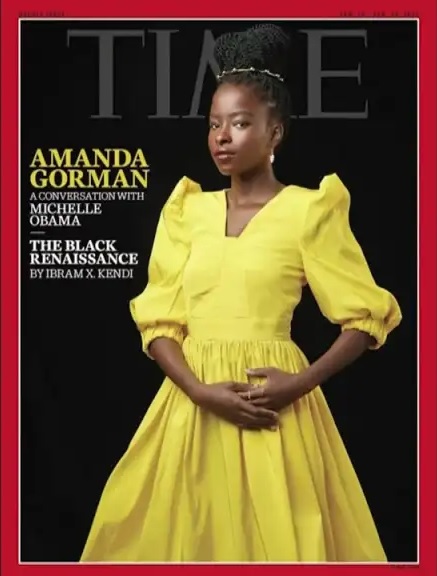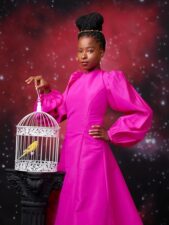See also Erizku – Nefertiti – Miles Davis (Gold)

Awol Erizku
American, 1988-
Untitled (Amanda) , 2021
digital c print
73 × 55 in.
SBMA, Museum purchase with funds provided by the Luria/Budgor Family Foundation
2021.9.2

Awol Erizku Photo by David Alekhuogie, courtesy the artist and Gagosian Gallery
RESEARCH PAPER
Assertive color is what first strikes the eye in Awol Erizku’s photograph of the poet and activist Amanda Gorman. An erect female figure wearing a vibrant yellow dress stands out against the dark background. The diamond shaped geometry of her posture -- elbows angled outward, hands clasped in her lap, creates an impression of suppressed energy. She gazes sternly, even assertively at the viewer. For this young woman, yellow has lost its association with cowardice and illness. A vertical line connecting her head and her hands links the brain that created “The Hill We Climb” with the hands that wrote it. “History has its Eyes on Us,” her poem proclaims (1/20/2021). Erizku has made every element in this photograph meaningful. Black designers created Amanda Gorman’s yellow dress as well as the gold necklace she wore in Washington, now repurposed into a kind of crown. Both the poem and the photograph celebrate Black Power, identity, and inclusion.
Awol Erizku is a multidisciplinary artist who works in painting, photography, and sculpture, often combining these elements into installations with Black historical and cultural significance. Born in Ethiopia in 1988, Erizku grew up in the Bronx housing projects of New York, won a full scholarship to The Cooper Union, which was founded on the principle that art education should be free to all qualified applicants regardless of race or religion. In 2010 he graduated with a Bachelor of Fine Arts degree followed by a Master of Fine Arts from Yale University in 2014. Deeply informed by his studies of traditional art history, Erizku creates works that blend that history with Black culture. In a series of witty photographs, he inserts Black subjects into Eurocentric masterpieces: Vermeer’s “The Girl with a Pearl Earring “becomes “Girl with a Bamboo Earring.” Leonardo's da Vinci’s “Lady with an Ermine” becomes “Lady with a Pitbull” (2009). Looking at these works involves a kind of double vision for some audiences, but those who encounter his work with fresh eyes see a statement that Black is Beautiful. Reaching new audiences is part of Erizku’s mission, and he displays that work on social media and Internet websites as well as in prestigious galleries. Erizku is part of a Black vanguard that wants to reclaim artistic expression from a tradition of largely white artists, subjects, and gallery gatekeepers. Early photographs of Black subjects by Kwame Brathwaite, have been followed by other Black artists gaining prominence in the U.S capital: Kahinde Wiley’s oil painting of President Obama for the National Portrait Gallery and Alston Littleson’s sculpture of the Nebraska novelist Willa Cather for Statuary Hall both open new opportunities for audiences to appreciate black artistic achievement.
Early fame came to Erizku in 2017 after he posted a photograph of Beyonce announcing her pregnancy on Instagram. His portraits of Black athletes, actors and other celebrities have graced the covers of Time Magazine and GQ. But Erizku rejects the idea that he is merely “a photographer for hire.” He wants to be remembered for Black imagination and for expanding the limits of Black art. He is known for creating striking installations that include found objects with Black historical or cultural resonance--boxing gloves, a basketball hoop, and a bust of Nefertiti. In 2022, the SBMA purchased “Nefertiti-Miles Davis Gold” (2022 215.1), a spinning disco head of Nefertiti covered in gold mirrors. (Purchased with funds provided by the Gail Wasserman Family Foundation and the Luria/Budgor Family Foundation, 2022 5.1). Erizku has also developed innovative ways to display his photographs in museum galleries. “Falcon,” (purchased by SBMA in 2021) is a polyfilm image displayed on a light table that illuminates the vibrant colors of the Falcon’s feathers. Glen Furman the founder of the Flagg Art Foundation aptly describes the complex pleasures of viewing Erizku’s work, “The work has an aesthetic appeal – you want to look at it – but there is always a lot going on within it.” In art galleries and museum shows as well as on the internet, Awol Erziku expands the consciousness of his viewers, creating new audiences and appreciation for our multiracial nation.
Prepared for the Santa Barbara Museum of Art Docent Council by Judy Messick, 2023
BIBLIOGRAPHY
Bailey, Stephanie. “Awol Erizuku’s Global Afropolitism.” OCULA, March 9, 2022 (online)
Bernal, Martin. “Black Athena: The Afro-asiatic Roots of Classical Civilization. “Free Association Books, 1987
Duron, Maximiliano. “At Gagosian, Awol Erizku Takes Apart the Sphinx to Offer New Possibilities for Imagination.” ARTNEWS, March 11, 2022
Monsoor, Sanya. “Awol Erizku: The Story Behind TIME’s Amanda Gorman Cover.” TIME, February 4, 2021.
Pogrebin, Robin. “Beyond Beonce Fame, Awol Erizkku Expands What Black Art Can Be,” NEW YORK TIMES, March 8 and 10, 2022.
Sargent, Antwon
Tyner, Ashley. “Artist Awol Erizku, On Creating New Black Mythologies.” March 11, 2022 (online)
Other web sites:
Artsy
ArtNet: Awol Erizku
Ben Brown Fine Arts

Awol Erizku's portrait of Gorman is an “indirect nod” to Maya Angelou. “It needed a layer of depth that only poetry can explain,” he says. “I was interested in allowing her to own the space that she’s in right now.” - Awol Erizku for TIME
COMMENTS
Amanda Gorman’s eloquent poetry at Joe Biden’s presidential Inauguration soothed many Americans still reeling just two weeks after pro-Trump supporters staged an insurrection at the Capitol.
“We will rebuild, reconcile and recover
and every known nook of our nation
and every corner called our country,
our people diverse and beautiful will emerge,
battered and beautiful.”
This week, Gorman—the youngest Inaugural poet in U.S. history—is featured on TIME’s cover, where the 22-year-old wears a bright yellow familiar from January’s event.
Conceptual artist Awol Erizku captured Gorman for TIME in what he hoped would be a “very timely arrival portrait.”
“I was interested in allowing her to own the space that she’s in right now,” Erizku says. “We were going for timelessness, something that felt classical” and tied in to the “resurgence of a Black renaissance.”
It was a special moment for him, too. “Like many who witnessed the recent presidential Inauguration, I was captivated by her poem and her exquisite delivery,” says Erizku, who is based in Los Angeles and has exhibited at institutions including New York City’s Museum of Modern Art and the Studio Museum in Harlem. “For TIME, I wanted to extricate her from the political dimension and immerse it in a more cosmic atmosphere to add to the weight of her words.”
In a separate image featured inside the magazine, Gorman holds a white birdcage in a nod to the birdcage ring she wore on inauguration day. (That ring was a gift from Oprah, referring to previous inauguration poet Maya Angelou’s poem, “I Know Why the Caged Bird Sings.”)
“It needed a layer of depth that only poetry can explain,” Erizku says of the image.
A team of Black creative professionals prepared Gorman for the portraits: Jason Bolden styled her, Autumn Moultrie did her makeup, Khiry provided jewelry and the dress was from Greta Constantine.
The magazine package also features typography from Tré Seals, the founder of Vocal Type foundry, who specializes in making type inspired by communities of color and social justice movements. “When a singular perspective dominates an industry, regardless of any advancements in technology, there can be (and has been) only one way of thinking, teaching and creating,” Seals says. His bold, declarative typography, in a font called Neue Black, opens the package with its defining statement: “THE RENAISSANCE IS BLACK.”
https://time.com/5935798/amanda-gorman-cover/
SBMA CURATORIAL LABELS
The young Black poet and activist Amanda Gorman achieved international renown for her electrifying performance of her poem "The Hill We Climb" at the January 20, 2021, inauguration of President Joe Biden and Vice President Kamala Harris. Gorman's expertly-crafted verse embraced themes of American injustice and conflict, while raising the prospect of healing and hope for a better day the future represented. After this remarkable event, Time magazine commissioned Awol Erizku to create a portrait of Gorman for its February 15, 2021 cover. For the photograph here, Erizku removed the magazine cover’s text to focus on Gorman herself, recalling the grand tradition of portraiture but leaving out props and background. Wearing a vibrant yellow dress that echoes her indelible Inauguration Day coat, Gorman casts a sure and steady gaze that immediately engages and holds the viewer. With restraint and focus, Erizku allows the confident and inspirational presence of Gorman to radiate outward from the photograph's boundaries.
- A Time of Gifts, 2022
